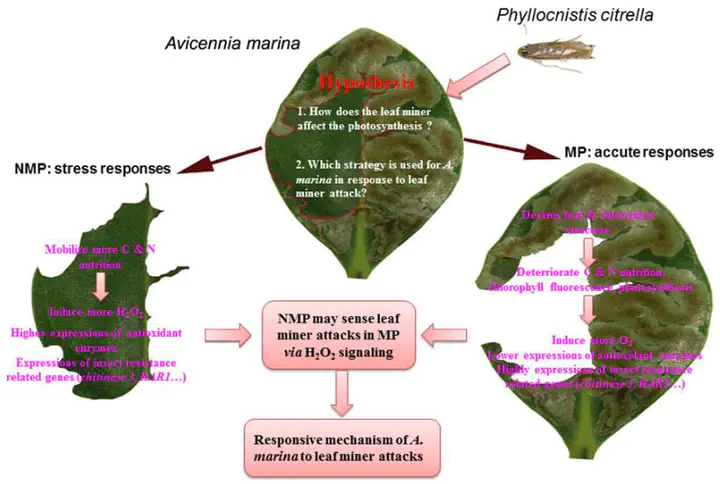Leaf miner-induced morphological, physiological and molecular changes in mangrove plant Avicennia marina (Forsk.) Vierh

Abstract
Avicennia marina (Forsk.) Vierh is a widespread mangrove species along the southeast coasts of China. Recently, the outbreak of herbivorous insect, Phyllocnistis citrella Stainton, a leaf miner, have impacted on the growth of A. marina. Little is reported about the responses of A. marina to leaf miner infection at the biochemical, physiological and molecular levels. Here, we reported the responses of A. marina to leaf miner infection from the aspects of leaf structure, photosynthesis, and antioxidant system and miner responsive genes expression. A. marina leaves attacked by the leaf miner exhibited significant decreases in chlorophyll, car- bon and nitrogen contents, as well as a decreased photosynthetic rate. Scanning and transmission electron microscopic observa- tions revealed that the leaf miner only invaded the upper epidermis and destroyed the epidermal cell, which lead to the exposure of salt glands. In addition, the chloroplasts of mined leaves (ML) were swollen and the thylakoids degraded. The maximal net photosynthetic rate, stomatal conductance (Gs), carboxylation efficiency (CE), dark respiration (Rd), light respiration (Rp) and quantum yields (AQE) significantly decreased in the ML, whereas the light saturation point (Lsp), light compensation point (Lcp), water loss and CO2 compensation point (Г) increased in the ML. Moreover, chlorophyll fluorescence features also had been chan- ged by leaf miner attacks. Interestingly, higher generation rate of O2ˉ· and lower antioxidant enzyme expression in the mined por- tion (MP) were found; on the contrary, higher H2O2 level and higher antioxidant enzyme expression in the non-mined portion (NMP) were revealed, implying that the NMP may be able to sense that the leaf miner attacks had happened in the MP of the A. marina leaf via H2O2 signaling. Besides, the protein expression of glutathione S-transferase (GST) and the glutathione (GSH) con- tent were increased in the ML. In addition, insect resistance-related gene expression such as chitinase 3, RAR1, topless and PIF3 had significantly increased in the ML. Taken together, our data suggest that leaf miners could significantly affect leaf structure, photosynthesis, the antioxidant system and miner responsive gene expression in A. marina leaves.